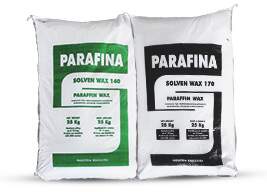
Paraffin 140/145 FG Specification and Safety Information
DESCRIPTION
SOLVEN WAX 140 – FOOD GRADE is essentially composed of saturated hydrocarbons and low contents of polyaromatic hydrocarbons. Its content of Polycyclic Aromatics meets FDA standards. It has excellent chemical stability.
PROPERTIES
See the tests, specification, Solven method and reference method in the PDF file available for download.
APPLICATION / MAIN USES
SOLVEN WAX 140 FOOD GRADE is used in waterproofing papers and canvas, candle making, wax composition in general, rubber additives, chemical industry and food industry.
PACKAGING, STORAGE AND HANDLING
SOLVEN WAX 140 FOOD GRADE should be stored in a cool, dry place, protected from bad weather. The supply is made through bags or boxes. The shelf life of this product is 03 years from the date of manufacture, under the recommended storage conditions and/or original packaging.
CLASSIFICATION FOR TRANSPORT
This product is not classified as hazardous according to current legislation.
STORAGE
Store in boxes. Keep preferably in places free from sunlight. Provide good room ventilation at room temperature and atmospheric pressure. Keep in a dry environment, away from heat, oxidants and strong sources of ignition.
PHYSICAL AND CHEMICAL PROPERTIES
Aspect:
- Physical state: Solid at room temperature;
- Color: Milky White.
Smell: Characteristic.
pH: Not applicable.
Melting Point: 61.4°C (ASTM Method D-87).
Flash Point: 244 +/-4 ºC (Open Cup).
Boiling Point: 290 °C at 101.325 kPa (760 mmHg).
Density: 0.780 at 80°C.
Solubility in water: Insoluble.
In organic solvents: Soluble in toluene (14.5 / 100g at 20 ºC).
Viscosity: 5.53 Cst at 90°C.
STABILITY AND REACTIVITY
Stability: Stable.
Hazardous Reactions: Keep away from strong chemical oxidizers (eg peroxides, nitric acid, concentrated sulfuric acid), halogenated hydrocarbons, alkali hydroxides, halogens, ethane amines, alkali metals, nitrous compounds. Reacts with many plastic materials.
Conditions to avoid: Sources of heat and ignition.
TOXICOLOGICAL INFORMATION
Acute Toxicity: In high concentrations of smoke, it can cause nausea, headache, dizziness and anesthetic effects.
- Inhalation: When inhaled, fumes cause mucosal irritation. In high concentrations, inhaled vapors have a narcotic and anesthetic effect, and can cause headache, dizziness, nausea, drowsiness, malaise and loss of consciousness. In solid state it is inert;
- Skin Contact: Associated with other chemical components, it may cause irritation due to hypersensitivity;
- Eye Contact: Negligible;
- Ingestion: No records found;
- Specific effects: As it is a solid product, other effects, other than the skin, only occur in cases of production of vapors due to abnormal heating. In liquid state, avoid contact with eyes and skin, due to risk of burns.
ECOLOGICAL INFORMATION
Mobility: Non-Volatile.
Environmental impact: In normal state it does not cause damage to the atmosphere.
Ecotoxicity: Effects on aquatic organisms – given its chemical inertness characteristics, low solubility, it is not liable to harm life. Effects on soil organisms – not likely to cause soil damage.
CONSIDERATIONS ON FINAL DESTINATION
Treatment and disposal methods:
- Product: the treatment and disposal of the product must be technically evaluated on a case-by-case basis;
- Product waste: Dispose of properly according to local legislation. Incineration or kiln processing are suitable methods for disposal;
- Contaminated packaging: empty packaging must be cleaned before recycling or final disposal at an authorized facility. Do not reuse empty packaging.